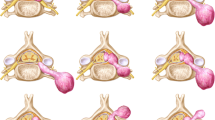Abstract
Purpose
The purpose of this study was to investigate follow-up MR findings of spinal foraminal nerve sheath tumors after stereotactic irradiation.
Materials and methods
Thirty-five foraminal nerve sheath tumors in 28 patients who underwent stereotactic radiosurgery (SRS) (n = 28) or stereotactic radiotherapy (SRT) (n = 7) were included. The MR images were reviewed to identify serial changes in tumor volume and intratumoral necrosis. Growth and shrinkage were defined as volume changes of ±19.7 % or more; stability was within ±19.7 %. Transient swelling was defined as shrinkage preceded by significant growth. A tumor with shrinkage or stability was regarded as tumor control.
Results
Of 35 tumors, 16 (46 %) were stable, 14 (40 %) shrunk, and 5 (14 %) grew. Transient swelling was seen for 13 (37 %) lesions. Newly developed intratumoral necrosis was observed for 19 (54 %) of 35 tumors and was significantly associated with transient swelling (p = 0.039) and with tumor control (p = 0.017). SRS was not significantly associated with transient swelling.
Conclusion
In follow-up MR images of spinal foraminal nerve sheath tumors after stereotactic irradiation, newly developed intratumoral necrosis and transient swelling were often seen. Intratumoral necrosis was associated with transient swelling and tumor control.


Similar content being viewed by others
References
Murovic JA, Charles Cho S, Park J. Surgical strategies for managing foraminal nerve sheath tumors: the emerging role of CyberKnife ablation. Eur Spine J. 2010;19:242–56.
Barnett GH, Linskey ME, Adler JR, Cozzens JW, Friedman WA, Heilbrun MP, et al. Stereotactic radiosurgery—an organized neurosurgery-sanctioned definition. J Neurosurg. 2007;106:1–5.
van de Langenberg R, Dohmen AJ, de Bondt BJ, Nelemans PJ, Baumert BG, Stokroos RJ. Volume changes after stereotactic LINAC radiotherapy in vestibular schwannoma: control rate and growth patterns. Int J Radiat Oncol Biol Phys. 2012;84:343–9.
Chang UK, Rhee CH, Youn SM, Lee DH, Park SQ. Radiosurgery using the Cyberknife for benign spinal tumors: Korea Cancer Center Hospital experience. J Neurooncol. 2011;101:91–9.
Gerszten PC, Burton SA, Ozhasoglu C, McCue KJ, Quinn AE. Radiosurgery for benign intradural spinal tumors. Neurosurgery. 2008;62:887–95. (discussion 95–6).
Murovic JA, Gibbs IC, Chang SD, Mobley BC, Park J, Adler JR Jr. Foraminal nerve sheath tumors: intermediate follow-up after cyberknife radiosurgery. Neurosurgery. 2009;64:A33–43.
van de Langenberg R, de Bondt BJ, Nelemans PJ, Baumert BG, Stokroos RJ. Follow-up assessment of vestibular schwannomas: volume quantification versus two-dimensional measurements. Neuroradiology. 2009;51:517–24.
Nakamura H, Jokura H, Takahashi K, Boku N, Akabane A, Yoshimoto T. Serial follow-up MR imaging after gamma knife radiosurgery for vestibular schwannoma. AJNR Am J Neuroradiol. 2000;21:1540–6.
Yu CP, Cheung JY, Leung S, Ho R. Sequential volume mapping for confirmation of negative growth in vestibular schwannomas treated by gamma knife radiosurgery. J Neurosurg. 2000;93(Suppl 3):82–9.
Okunaga T, Matsuo T, Hayashi N, Hayashi Y, Shabani HK, Kaminogo M, et al. Linear accelerator radiosurgery for vestibular schwannoma: measuring tumor volume changes on serial three-dimensional spoiled gradient-echo magnetic resonance images. J Neurosurg. 2005;103:53–8.
Hasegawa T, Kida Y, Yoshimoto M, Koike J, Goto K. Evaluation of tumor expansion after stereotactic radiosurgery in patients harboring vestibular schwannomas. Neurosurgery. 2006;58:1119–28. (discussion 1128).
Meijer OW, Weijmans EJ, Knol DL, Slotman BJ, Barkhof F, Vandertop WP, et al. Tumor-volume changes after radiosurgery for vestibular schwannoma: implications for follow-up MR imaging protocol. AJNR Am J Neuroradiol. 2008;29:906–10.
Timmer FC, Hanssens PE, van Haren AE, van Overbeeke JJ, Mulder JJ, Cremers CW, et al. Follow-up after gamma knife radiosurgery for vestibular schwannomas: volumetric and axial control rates. Laryngoscope. 2011;121:1359–66.
Gerszten PC, Burton SA. Clinical assessment of stereotactic IGRT: spinal radiosurgery. Med Dosim. 2008;33:107–16.
Dodd RL, Ryu MR, Kamnerdsupaphon P, Gibbs IC, Chang SD Jr, Adler JR Jr. CyberKnife radiosurgery for benign intradural extramedullary spinal tumors. Neurosurgery. 2006;58:674–85. (discussion 685).
Acknowledgments
This work was supported by a grant from Inje University in 2012.
Conflict of interest
The authors declare that they have no conflict of interest.
Author information
Authors and Affiliations
Corresponding author
About this article
Cite this article
Kang, H.J., Hwang, Y.J., Kim, Y.H. et al. Follow-up MR findings of spinal foraminal nerve sheath tumors after stereotactic irradiation. Jpn J Radiol 31, 192–196 (2013). https://doi.org/10.1007/s11604-012-0169-1
Received:
Accepted:
Published:
Issue Date:
DOI: https://doi.org/10.1007/s11604-012-0169-1




